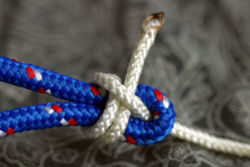(Marked this version for translation) |
|||
| Line 8: | Line 8: | ||
|tying_instructions = | |tying_instructions = | ||
To tie the double sheet bend, start by making a bight in the larger line. Pass the working end of the smaller line up through the bight, around behind the bight, and beneath the loop in the smaller line (that's a sheet bend). Then once again, pass the working end along the same path, around behind the bight and beneath the loop in the smaller line. | To tie the double sheet bend, start by making a bight in the larger line. Pass the working end of the smaller line up through the bight, around behind the bight, and beneath the loop in the smaller line (that's a sheet bend). Then once again, pass the working end along the same path, around behind the bight and beneath the loop in the smaller line. | ||
| − | |warnings=As with the standard sheet bend, the two free ends should end up on the same side of the knot. | + | |warnings=As with the standard sheet bend, the two free ends should end up on the same side of the knot. If they do not, a ''left-handed double sheet bend'' results, which is much weaker. |
}} | }} | ||
<noinclude></translate></noinclude> | <noinclude></translate></noinclude> | ||
[[Category:Adventist Youth Honors Answer Book|{{SUBPAGENAME}}]] | [[Category:Adventist Youth Honors Answer Book|{{SUBPAGENAME}}]] | ||
Revision as of 14:18, 8 September 2021
| Double sheet bend |
|---|
|
Use: The double sheet bend or double becket bend is a strong knot used to tie two ropes (usually of different thicknesses or rigidity) together. It is a doubled version of the sheet bend.
How to tie:
WARNING: As with the standard sheet bend, the two free ends should end up on the same side of the knot. If they do not, a left-handed double sheet bend results, which is much weaker.
|

